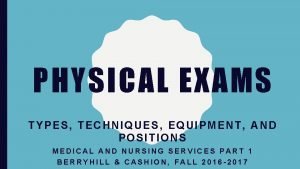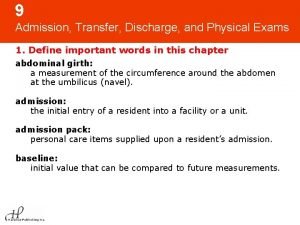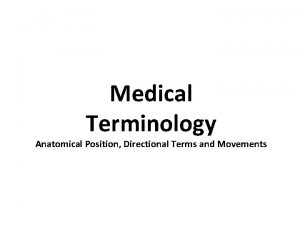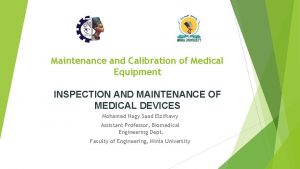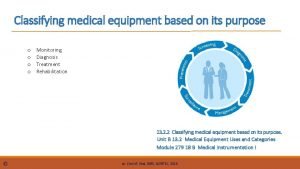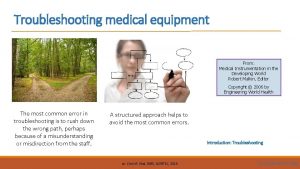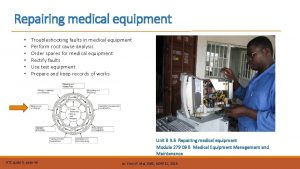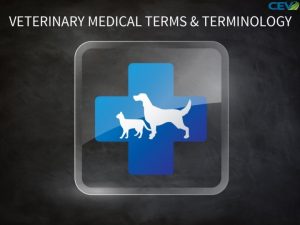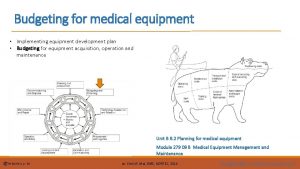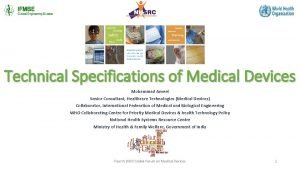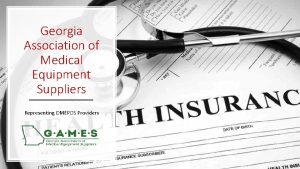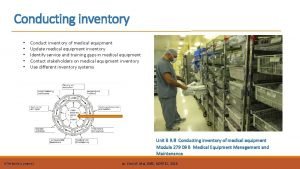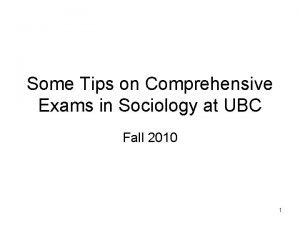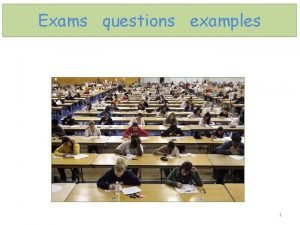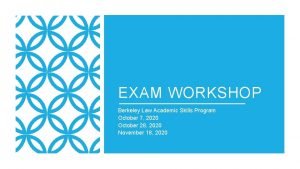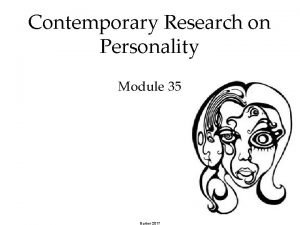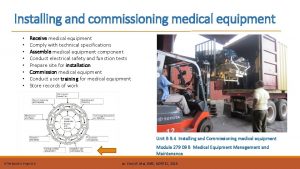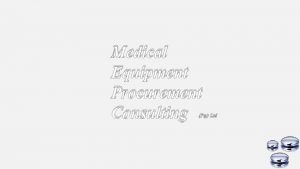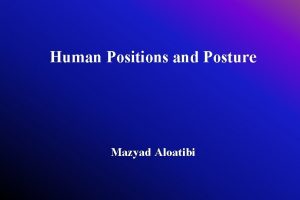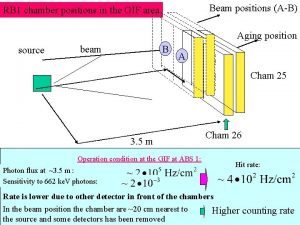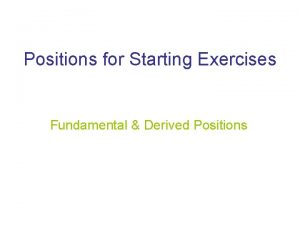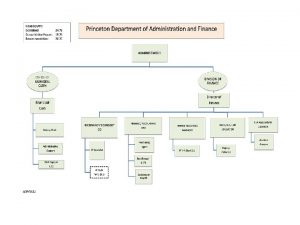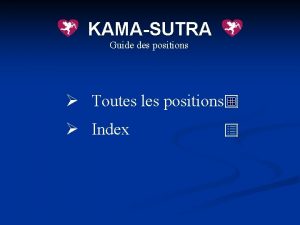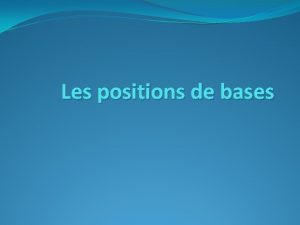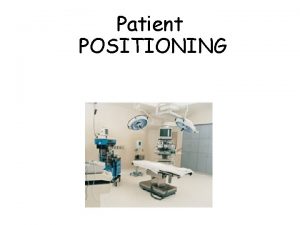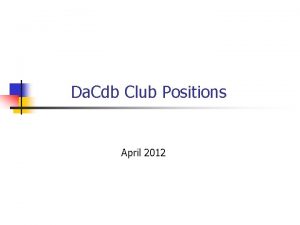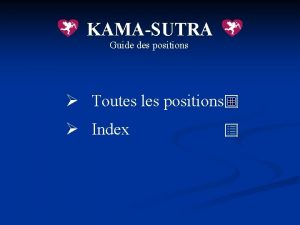PHYSICAL EXAMS TYPES TECHNIQUES EQUIPMENT AND POSITIONS MEDICAL


































- Slides: 34

PHYSICAL EXAMS TYPES, TECHNIQUES, EQUIPMENT, AND POSITIONS MEDICAL AND NURSING SERVICES PART 1 BERRYHILL & CASHION, FALL 2016 -2017

TYPES OF PHYSICAL EXAMS

TYPES OF PHYSICAL EXAMS 3 major kinds of examinations are: 1. EENT 2. GYN 3. General, or complete, physical

MAIN TYPES OF PHYSICAL EXAMS 1. EENT: Eye, ear, nose & throat exam 2. GYN (gynecological): exam of female reproductive organs=vagina, cervix, uterus, ovaries, & breasts. A Pap (Papanicolaou) test is usually done to detect cancer of the cervix or reproductive organs

MAIN TYPES OF PHYSICAL EXAMS 3. General, or complete, physical: all areas of the body are examined; blood, urine, radiographs, & electrocardiogram may be done. An EENT and/or GYN exam may be done during this exam.

PHYSICAL EXAM TECHNIQUES

PHYSICAL EXAMS TECHNIQUES 4 main techniques used during exams: 1. Observation 2. Palpation 3. Percussion 4. Auscultation

PHYSICAL EXAMS TECHNIQUES 1. Observation: inspection Physician looks at the pt to observe things Example: skin color, rash, swelling, deformities, etc.

PHYSICAL EXAMS TECHNIQUES 2. Palpation: feeling Physician uses their hands to feel various parts of the body. They are feeling for enlargement, anything out of place, or painful areas https: //www. youtube. com/watch? v=a. SPq. Xd 9 PILo (2: 15)

PHYSICAL EXAMS TECHNIQUES 3. Percussion: tapping Physician taps & listens for sounds. They place fingers of one hand on a part of the body, then use the fingers of the other hand to tap the body part. The sound emitted tells them the size, density, & position of underlying organs https: //www. youtube. com/watch? v=P 4 Ryk 5 IKf_4 (1: 10)

PHYSICAL EXAMS TECHNIQUES 4. Auscultation: listening Physician uses a stethoscope to listen to sounds coming from within the body. Can listen to heart, lungs, and intestines

PHYSICAL EXAM EQUIPMENT

PHYSICAL EXAM EQUIPMENT Some of the instruments and equipment used for different exams can include: • • • Cervical spatula (Ayer blade) Laryngeal mirror Ophthalmoscope Otoscope Percussion (reflex hammer) Sigmoidoscope • • • Speculum Sphygmomanometer Stethoscope Tongue blade/depressor Tuning fork

PHYSICAL EXAM EQUIPMENT Cervical spatula (Ayer blade): wooden or plastic blade used to scrape cells from the cervix usually done as part of a Pap smear to check for cancer.

PHYSICAL EXAM EQUIPMENT Laryngeal mirror: instrument with a mirror at one end to examine the larynx

PHYSICAL EXAM EQUIPMENT Ophthalmoscope: lighted instrument used to examine the eyes

PHYSICAL EXAM EQUIPMENT Otoscope: lighted instrument used to examine the ears

PHYSICAL EXAM EQUIPMENT Percussion (reflex) hammer: used to test tendon reflexes

PHYSICAL EXAM EQUIPMENT Sigmoidoscope: lighted instrument used to examine the sigmoid colon

PHYSICAL EXAM EQUIPMENT Speculum: instrument used to examine internal canals of the body (nasal speculum, vaginal speculum, rectal speculum)

PHYSICAL EXAM EQUIPMENT Sphygmomanometer: instrument used to measure BP

PHYSICAL EXAM EQUIPMENT Stethoscope: instrument used for listening to internal body sounds

PHYSICAL EXAM EQUIPMENT Tongue blade/depressor: wood or plastick used to depress (hold down) the tongue so the throat can be examined

PHYSICAL EXAM EQUIPMENT Tuning fork: instrument with two prongs used to test hearing acuity

POSITIONS FOR PHYSICAL EXAMS

PHYSICAL EXAM POSITIONS Supine: used for examination of the anterior side • Pt lies flat on back with legs slightly apart

PHYSICAL EXAM POSITIONS Prone: used for examination of the back or spine • Pt lies on abd & turns head to either side

PHYSICAL EXAM POSITIONS Lateral: used for simple rectal & sigmoidoscopic exams, enemas, rectal temps • Pt lies on left side

PHYSICAL EXAM POSITIONS Fowler’s positions: used to facilitate breathing, relieve distress, encourage drainage, & examine the head, neck, & chest • Low Fowler’s: HOB elevated to 25 degrees • Semi-Fowler’s: HOB elevated to 45 degrees • High Fowler’s: HOB elevate to 90 degrees

PHYSICAL EXAM POSITIONS Low Fowler’s

PHYSICAL EXAM POSITIONS Semi-Fowler’s

PHYSICAL EXAM POSITIONS High Fowler’s

PHYSICAL EXAM POSITIONS Lithotomy: used for vaginal exams, Pap tests, urinary catherizations, cystoscopic exams, & surgery of the pelvic area • Pt lies supine with knees separated & flexed & feet in stirrups

PHYSICAL EXAM POSITIONS Trendelenburg: used to increase circulation of blood to the head and brain, during shock, or for surgery on pelvic organs • Pt lies supine with the bed elevated at the feet (head is lower than the feet)
 Equipment used for physical examination
Equipment used for physical examination Chapter 9 admission transfer discharge and physical exams
Chapter 9 admission transfer discharge and physical exams Chapter 9 admission transfer discharge and physical exams
Chapter 9 admission transfer discharge and physical exams Foot movements terms
Foot movements terms Semi recumbent position
Semi recumbent position Standing erect with palms facing forward
Standing erect with palms facing forward Cardiac bed definition
Cardiac bed definition Hospital equipments suppliers
Hospital equipments suppliers Medical equipment vocabulary
Medical equipment vocabulary Troubleshooting medical equipment
Troubleshooting medical equipment Troubleshooting medical equipment
Troubleshooting medical equipment Tnt veterinary abbreviation
Tnt veterinary abbreviation Durable medical equipment conference
Durable medical equipment conference Medical equipment budgeting
Medical equipment budgeting Medical equipment technical specifications
Medical equipment technical specifications Medical equipment suppliers association
Medical equipment suppliers association Medical equipment inventory list
Medical equipment inventory list Beijing medical equipment institute
Beijing medical equipment institute Enclosures for medical equipment
Enclosures for medical equipment Proctor medical equipment
Proctor medical equipment Difference between medical report and medical certificate
Difference between medical report and medical certificate Other initiated self repair example
Other initiated self repair example Classification of cutting tools
Classification of cutting tools Fonctions techniques et solutions techniques
Fonctions techniques et solutions techniques Poem structure and form
Poem structure and form Finland exams
Finland exams Adit registration
Adit registration Comprehensive exams
Comprehensive exams Exam prayer to st joseph of cupertino
Exam prayer to st joseph of cupertino Prayer before a test
Prayer before a test New york state teacher certification examinations
New york state teacher certification examinations Example exam
Example exam Berkeley law exams
Berkeley law exams English official exams
English official exams John is generally pleasant but during final exams
John is generally pleasant but during final exams
